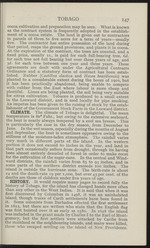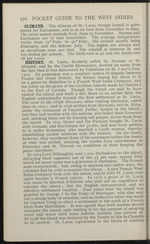| 1 |
 |
“...Ordinance and a statutory form of contract has been estab-
I lished. Rubber (Castilloa elastica and Hevea brasiliensis) was
I planted to a considerable extent during the boom of 1910, but
I it has been practically abandoned, being unable to compete
I with rubber from the East where labour is more cheap and
I plentiful. Limes are. being planted, the soil being very suitable
I for citrus cultivation. Tobacco is produced to a small extent
I in the Leeward distrjtt, and is used locally for pipe smoking.
I An impetus has been given to the raising of stock by the estab-
I lishment of the Government Stock Farm in the Leeward district.
CLIMATE. The climate of Tobago is delightful. The mean
temperature is 8o° Fahr., but owing to the extensive seaboard,
I the heat is nearly always tempered by a cool sea breeze. This
I is particularly the case in the dry season, from December to
I June. In the wet season, especially during the months of August
I and September, the heat is sometimes oppressive owing...”
|
|
| 2 |
 |
“...the grant of the Caribbee Islands made by Chanes I
to the Earl of Carlisle. Though the Dutch are said to have
visited the island and built a fort there at an earlier date, the
English undoubtedly formed the first settlement in St. Lucia.
The crew of the Oliph Blossome, after visiting Barbados, called
there in 1605 ; and in 1638 settlers from Bermuda and St. Kitts,
under the command of Captain Judlee, landed in the island ,
but they had trouble with the natives, who killed their Governor
and, smoking them out by burning red pepper, drove them from
the island. In 1650 Houel and Du Parquet bought St. Lucia
with Grenada and Martinique for £1,660, and sent forty settles
to it under Rousselan, who married a Carib woman, thereby
establishing cordial relations with the natives. On his death,
however, they murdered three of his successors before the treaty
of 1660 was settled, securing the Caribs from interference in
Dominica and St. Vincent on condition of their keeping the
peace elsewhere. -
In...”
|
|
